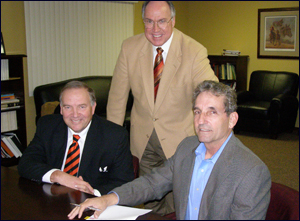OSU lends support to sustainable energy technology start-up
Wednesday, January 24, 2007

A partnership with Oklahoma State University’s Center for Innovation and Economic Development may bring Payne County a start-up company with roots at the University of Oklahoma.
Sustainable energy system provider SOL Inc., whose building products are based on
research developments by OU College of Architecture Associate Dean James Patterson,
will first consider Payne County as a site for its manufacturing operations as part
of an agreement with OSU CIED.
“We’ll be located where it makes the most financial sense to do so, with preference
to Payne County,” said David Orme, CEO of SOL Inc.
OSU CIED President Joe Alexander said investment in emerging Oklahoma start-ups complements
the center's mission. The center exists to further OSU’s commitment to economic development
through sharing university know-how, building entrepreneurial strengths, and participating
in regional strategic alliances that create jobs and wealth for Oklahomans.
“When President Schmidly organized this center, one of our missions was to create
good jobs for Oklahomans, and this investment is just one of the steps that allow
us to do that,” Alexander said. “We’re going to invest in two types of companies ...
Oklahoma companies or companies that are going to move to Oklahoma.”
“We had known David before he went with SOL,” Alexander said of Orme, an OSU engineering
alumnus and former vice president of manufacturing and provisioning at Lucent Technologies.
“We have a lot of confidence in the company and its leadership, and we are really
pleased to partner with them.”
For use in existing buildings as well as new construction, SOL’s products are designed
to improve profitability by conserving energy and natural resources. Its first, the
patented Horizontal Opening Solar Solution, will be marketed primarily to large retailers,
an industry sector whose annual $9.5 billion expense for heating, ventilation and
air conditioning and lighting is second only to payroll.
“The SOL HOSS is an energy management system we’re in the process of developing for
skylights and window openings,” Orme said. “It effectively addresses energy conservation
in the retail sector by minimizing heat coming into a building while maximizing daylighting,
an improvement on retail display appeal.”
Patterson developed the technology, initially at Iowa State University and later at
OU, while heading a research project for the Department of Energy. He, Brooks Hull,
director of development for OU’s College of Engineering, and Robert Workman, CEO of
Tulsa architecture and engineering firm BSW International, co-founded SOL Inc. in
2003 to produce it. The entrepreneurs eventually turned to i2E, the technology commercialization
arm of the Oklahoma Center for the Advancement of Science and Technology.
i2E evaluated the HOSS technology and assisted with market research and development
of a business plan. The commercialization center also provided SOL financial assistance
and helped the entrepreneurs obtain additional support, suggesting they contact OSU
CIED.
“We have a small amount of funds that we are making available, in exchange for an
equity interest, to companies where we see an opportunity to get a return on investment,”
said Tom Gray, CIED vice president for economic development. “With this seed capital,
OSU and i2E are helping launch and commercialize SOL’s innovative technology and create
jobs in the state.”
“They’ll use this funding to produce the first production models,” Gray said.
According to Orme, the effectiveness of the HOSS system is supported by computational
data and extensive evaluation by Lawrence Berkeley Laboratory, an independent testing
facility. Still, SOL hopes to validate the product at a large, live demonstration
site.
“We expect to have the prototypes done in three or four months, and we’ll start marketing
it then,” Orme said. “We would really like to have a big building — a Walmart or a
Lowe’s or a Home Depot — as the beta site where we can actually track the total energy
consumption with and without the system to prove its viability.”
